A Study on Sugar Content Improvement and Distribution Flow Response through Citrus Sugar Content Prediction Based on the PyCaret Library
Abstract
1. Introduction
2. Research Scope and Methodology
- Area: Tangerine data from seven open-field environments on Jeju Island (Yongheung, Seongsan, Tosan, Ara, Mureung, Hawon, Deokcheon) (Figure 1).
- 2.
- Period and Data Types:
- Data Preparation: We utilized 438 actual time-series data points from October to November 2016 and from August to November annually from 2017 to 2023.
- Data Augmentation: We augmented the dataset to include 1314 data points due to limited available data.
- Data Types: We used only seven of the 13 factors in this experiment. We limited the use to seven factors to focus on aspects relevant to sweetness, including two related to sweetness and five weather-related factors applicable to smart farming. This restriction allows for adjustments and applications in smart agriculture based on research outcomes.
- 3.
- Data Collection: We obtained tangerine sweetness and weather data for seven regions in Jeju Island from the National Institute of Horticultural and Herbal Science, Rural Development Administration. The data were secured through a web page providing tangerine quality information and weather data, and we prepared the data for extensive data analysis through data augmentation techniques for deep learning.
- 4.
- Machine Learning Method: PyCaret library.
3. Related Research
3.1. Reality of Agriculture
3.2. Tangerine Production and Fruit Distribution Market
3.3. Deep Learning and Big Data Analysis
3.4. PyCaret Library
- Data preprocessing: it automatically handles processes such as handling missing values, feature scaling, encoding, and data splitting.
- Model training and selection: it easily trains various machine learning models and compares them to select the optimal model.
- Hyperparameter tuning: it optimizes model performance through grid search or random search.
- Model analysis: it provides various tools (e.g., confusion matrix, ROC curve) for evaluating and analyzing model performance.
- Model deployment: this feature enables the easy deployment of created models, either through providing APIs or integrating them into web applications.
4. Improving Fruit Quality
4.1. Correlation between Citrus Quality and Sugar Content
- Ripeness (Sweetness): Tangerines’ sweetness naturally increases during ripening. Ripe tangerines contain more sugars, resulting in a sweeter taste. Therefore, sweetness reflects tangerines’ ripeness, with tangerines with higher sweetness generally considered better quality.
- Consumer Preferences: Most consumers prefer fruits with a more pungent sweet taste. As the sweetness of tangerines increases, consumer satisfaction typically rises, positively impacting the overall quality assessment of the fruit.
- Variety Differences: There may be natural variations in sweetness depending on the variety of tangerines. Some varieties boast higher sweetness compared to others. Therefore, variety selection is an essential factor in determining the sweetness and quality of tangerines.
4.2. Correlation between Citrus Quality and Sugar Content
- Environmental Factors:
- Climate Conditions: Tangerine sweetness is greatly influenced by climate conditions, especially temperature and sunlight during the growing season. Generally, lower temperatures and higher sunlight levels help increase tangerine sweetness.
- Soil Conditions: Well-drained soil with rich nutrients contributes to tangerines’ healthy growth and high sweetness.
- Genetic Factors:
- Variety Selection: Tangerine sweetness can vary significantly depending on the variety. Certain varieties are naturally bred to be sweeter than others.
- Cultivation Practices:
- Moisture Management: Excessive irrigation can decrease the sweetness of the fruit. Proper water management is essential for increasing the sweetness of the fruit.
- Fertilizer Usage: Excessive use of nitrogen fertilizers can decrease sweetness, while appropriate fertilizer application enhances the sweetness and quality of the fruit.
- Pruning and Thinning: Proper pruning and thinning provide more nutrients and light to the fruit, increasing sweetness.
- Post-Harvest Management:
- Harvest Timing: Since tangerines’ sweetness varies with ripeness, harvesting them at optimal ripeness is essential. Generally, fruit is the sweetest when fully ripe.
- Post-Harvest Handling: Storing the fruit at appropriate temperature and humidity after harvest is crucial for maintaining sweetness.
4.3. 13 Comprehensive Elements of Citrus Production
5. Deep Learning and Analysis Using PyCaret Library
5.1. PyCaret Deep Learning and Visualization
- Install PyCaret: First, PyCaret needs to be installed. Since PyCaret has various dependencies, it should be installed in a virtual environment.
- Data Preparation: For time series forecasting, a dataset containing citrus fruit-related weather information is needed. This dataset should include weather features such as temperature, precipitation, humidity, wind speed, etc., indexed by date and time.
- PyCaret Environment Setup: Use the setup function of PyCaret to set up the environment for time series forecasting tasks. Specify the dataset, target variable, and the periodicity of the time series data.
- Model Creation and Comparison: Use the compare_models function to automatically compare multiple time series forecasting models and select the best-performing one.
- Model Tuning: Tune the selected model using the tune_model function to improve performance.
- Perform Prediction: Use the predict_model function to predict weather information for future periods.
- Result Visualization: PyCaret provides various methods for visualizing prediction results. It can visualize the comparison between predicted and actual values, evaluate model performance, etc.
- Performance Metric Visualization:
- Loss and Accuracy Curves: Plot loss and accuracy during the training process epoch by epoch to visually represent how well the model is learning. This can be done using libraries like Matplotlib or Seaborn.
- Prediction Result Visualization:
- Actual vs. Predicted Values: For regression problems, plot a scatter plot comparing actual values with the model’s predicted values to visualize the model’s prediction accuracy.
- Confusion Matrix for Classification Problems: Visualize the confusion matrix to understand how well the model classified different classes in a classification problem.
- Feature Importance:
- Feature Importance Plot: Generate a chart showing the most influential features for model prediction, especially applicable for tree-based deep learning models derived from algorithms like Random Forests.
- Filters, Feature Maps, Activations:
- CNN Filter Visualization: Visualize the patterns or features in images that each Convolutional Neural Network (CNN) filter responds to.
- Feature Map Visualization: Visualize the activation of feature maps in intermediate layers of CNNs to understand what features the model has learned from the images.
- Embedding Visualization:
- 2D/3D Embedding of High-dimensional Data: Use dimensionality reduction techniques like t-SNE or PCA to project high-dimensional data into a 2D or 3D space. This allows for visual inspection of clustering tendencies or outliers in the data.
- Interactive Dashboards:
- Interactive Dashboards using Dash and Streamlit: Provide analysis results in interactive web applications, allowing users to explore the results by adjusting various parameters.
5.2. Implementation and Experimentation
5.2.1. Implementation and Experiment Environment
- Regions: Limited to tangerine data from seven regions of non-greenhouse environments in Jeju Island (Yongheung, Seongsan, Tosan, Ara, Mureung, Hawon, Deokcheon).
- Types of Data: Seven selected factors (acidity, sugar-acidity ratio, temperature, humidity, precipitation, insolation, wind speed) + sweetness.
- 3.
- Data Occurrence: Actual data from October to November 2016 and from August to November annually from 2017 to 2023 were utilized.
- 4.
- Data Augmentation: Due to the limited availability of openly accessible data, data augmentation techniques were employed to expand the dataset.
- 5.
- Data Collection: Data on tangerine sweetness levels and weather conditions for various regions within Jeju were obtained from the National Institute of Horticultural & Herbal Science under the Rural Development Administration. Data augmentation techniques were used to prepare for data analysis to ensure reliability.
- 6.
- Machine Learning Method: The PyCaret library was utilized to conduct deep learning.
5.2.2. Analytical Visualization of Experiments
5.3. Analysis of Experiment Contents
6. Discussion
7. Conclusions
Author Contributions
Funding
Data Availability Statement
Conflicts of Interest
References
- Available online: https://www.public.harvestai.com/ (accessed on 7 May 2024).
- Seo, D.-M. Development of an Artificial Intelligence Model for Predicting Citrus Sugar Content based on Meteorological Data. J. Korea Contents Assoc. 2021, 21, 35–43. [Google Scholar]
- Available online: https://www.nihhs.go.kr/usr/main/mainPage.do (accessed on 7 May 2024).
- Available online: http://jcitrus.or.kr/index.htm (accessed on 7 May 2024).
- Fruit Growth and Quality Management System. Available online: https://fruit.nihhs.go.kr/citrus/citrusMain.do (accessed on 7 May 2024).
- Yoon, S.H.; Choi, M.H.; Park, J.Y. Data-driven smart farm prospects. In Proceedings of the Conference on Communications and Information Sciences, February 2022; Volume 2022, pp. 930–931. Available online: https://www.dbpia.co.kr/journal/articleDetail?nodeId=NODE11047759 (accessed on 7 May 2024).
- Park, S.K. Trends and Development of Smart Farm Prospect. In Proceedings of the Conference on Korean Society for Food Engineering, 2022; Volume 2017, pp. 49–78. Available online: https://db.koreascholar.com/Article/Detail/352644 (accessed on 7 May 2024).
- Available online: http://www.kidshankook.kr/news/articleView.html?idxno=1316 (accessed on 7 May 2024).
- Min, K.-B.; Park, H.-J. A Study on the Patent Trend of ‘Smart Farm’ in Domestic through Network Analysis. J. Korean Inst. Inf. Electron. Commun. Technol. 2022, 10, 413–422. [Google Scholar]
- Hyun, J.W.; Lee, S.C.; Ihm, Y.B.; Kim, D.H.; Ko, S.W.; Kim, K.S. Protective Effect of Iminoctadine tris(albesilate) and Kresoxim-methyl Fungicides to Citrus Postharvest Diseases caused by Penicillium spp. Korean J. Pestic. Sci. 2001, 5, 37–44. [Google Scholar]
- Kim, B.S.; Ko, S.B.; Moon, T.W.; Kim, M.S. A Review on the Structure of Processing, Storage, and Marketing in Jeju Citrus Industry; Research Report; Korea Rural Economic Institute: Naju, Republic of Korea, 2017; pp. 41–50. [Google Scholar]
- Kang, T.H. Time-Series Analysis of Livestock Prices and Volatilities. Korean J. Agric. Manag. Policy 2007, 34, 369–388. [Google Scholar]
- Yoon, B.S. Price Volatility, Seasonality and Day-of the Week Effect in Meat Markets. Korean J. Agric. Manag. Policy 2008, 35, 21–38. [Google Scholar]
- Kang, T.H. The Influences of Volume on Wholesale Price Stabilities for Fresh Vegetables. J. Agric. Econ. 2008, 49, 21–38. [Google Scholar]
- Jeong, K.S.; Ham, Y.K. The Price Volatility Spillover in Hanwoo Marketing Channel. Korean J. Agric. Manag. Policy 2006, 33, 716–728. [Google Scholar]
- Jeju Special Self-Governing Province. An Ordinance on the Production and Marketing of Tangerine. 2019. Available online: https://www.law.go.kr/LSW//ordinInfoP.do?ordinSeq=1285786 (accessed on 7 May 2024).
- Ko, B.-H. A Study on Price Volatility and Properties of Time-series for the Tangerine Price in Jeju. J. Korea Acad.-Ind. Coop. Soc. 2020, 21, 212–217. [Google Scholar]
- Kang, T.H. Nonlinear Dynamics of Vegetable Prices. J. Agric. Econ. 2004, 45. [Google Scholar]
- VanderPlas, J. Python Data Science Handbook: Essential Tools for Working with Data; O’Reilly Media, Inc.: Sebastopol, CA, USA, 2016. [Google Scholar]
- Gong, S.-W.; Hwang, D.-Y. A Study of Big Data Domain Automatic Classification Using Machine Learning. J. Korea Big Data Soc. 2018, 3, 11–18. [Google Scholar]
- Cootes, T.F.; Ionita, M.C.; Lindner, C.; Sauer, P. Robust and Accurate Shape Model Fitting Using Random Forest Regression Voting. In Proceedings of the Computer Vision–ECCV 2012: 12th European Conference on Computer Vision, Florence, Italy, 7–13 October 2012; pp. 278–291. [Google Scholar]
- PyCaret Low-Code Machine Learning. Available online: https://pycaret.org/ (accessed on 21 April 2022).
- Roh, S.; Kang, E.; Park, D.; Kang, Y.-M. A Sweet Persimmon Grading Algorithm using Object Detection Techniques and Machine Learning Libraries. J. Korea Multimed. Soc. 2022, 25, 769–782. [Google Scholar] [CrossRef]
- Wang, S.; Xie, W.; Yan, X. Effects of Future Climate Change on Citrus Quality and Yield in China. Sustainability 2022, 14, 9366. [Google Scholar] [CrossRef]
- Dong, Z.; Chen, M.; Srivastava, A.K.; Mahmood, U.H.; Ishfaq, M.; Shi, X.; Zhang, Y.; Moussa, M.G.; Li, X.; Hu, C.; et al. Climate changes altered the citrus fruit quality: A 9-year case study in China. Sci. Total Environ. 2024, 923, 171406. [Google Scholar] [CrossRef] [PubMed]
- Kader, A.A. Flavor Quality of Fruits and Vegetables. J. Sci. Food Agric. 2008, 88, 1863–1868. [Google Scholar] [CrossRef]
- Amiri-Zarandi, M.; Dara, R.A.; Duncan, E.; Fraser, E.D.G. Big Data Privacy in Smart Farming: A Review. Sustainability 2022, 14, 9120. [Google Scholar] [CrossRef]
- Rodriguez-Casado, A. The Health Potential of Fruits and Vegetables Phytochemicals: Notable Examples. Crit. Rev. Food Sci. Nutr. 2016, 56, 1097–1107. [Google Scholar] [CrossRef] [PubMed]
- Busatto, N.; Tadiello, A.; Trainotti, L.; Costa, F. Climacteric ripening of apple fruit is regulated by transcriptional circuits stimulated by cross-talks between ethylene and auxin. Plant Signal. Behav. 2017, 12, e1268312. [Google Scholar] [CrossRef] [PubMed]
- Trivedi, P.; Nguyen, N.; Hykkerud, A.L.; Häggman, H.; Martinussen, I.; Jaakola, L.; Karppinen, K. Developmental and environmental regulation of cuticular wax biosynthesis in fleshy fruits. Front. Plant Sci. 2019, 10, 431. [Google Scholar] [CrossRef] [PubMed]
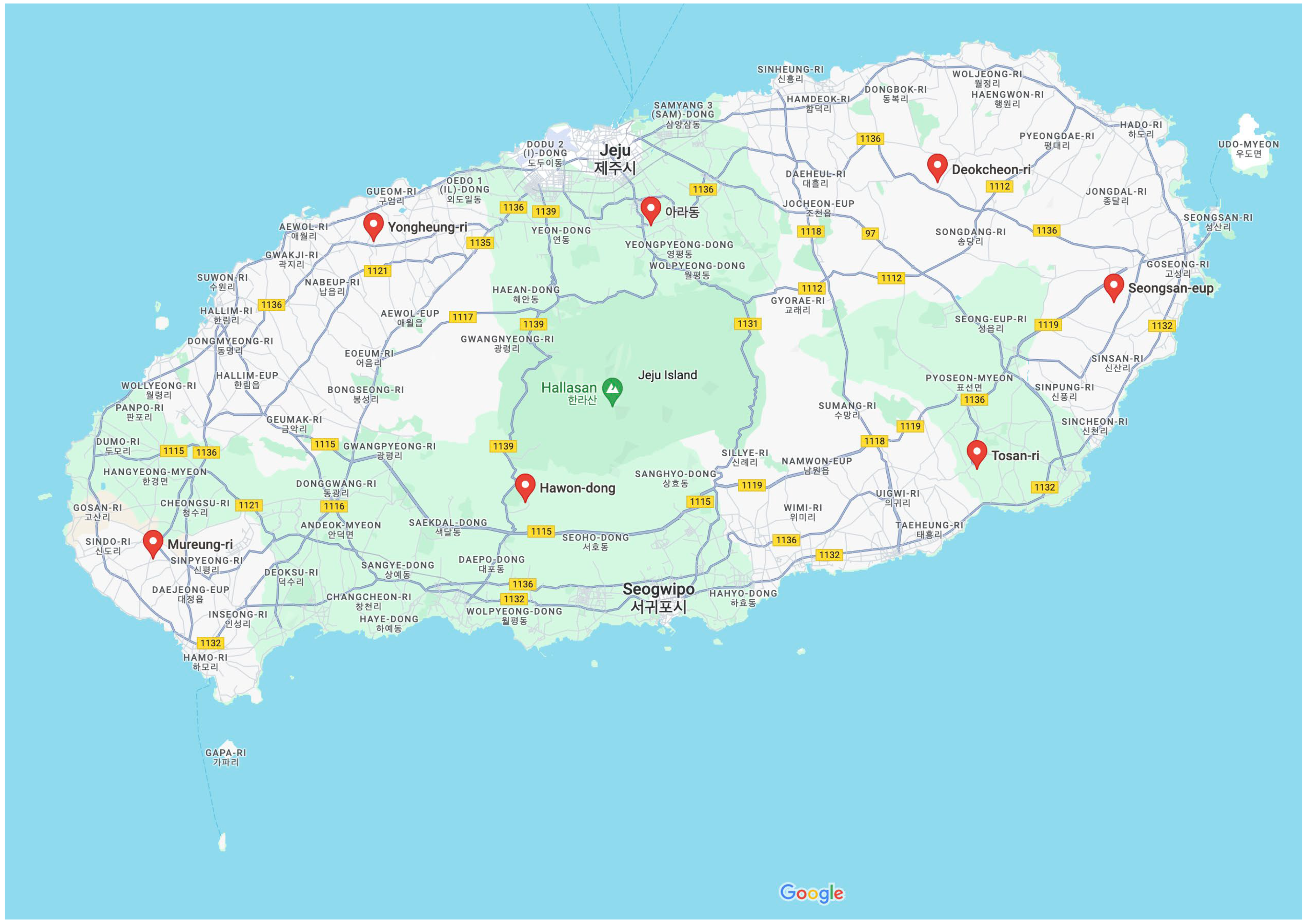
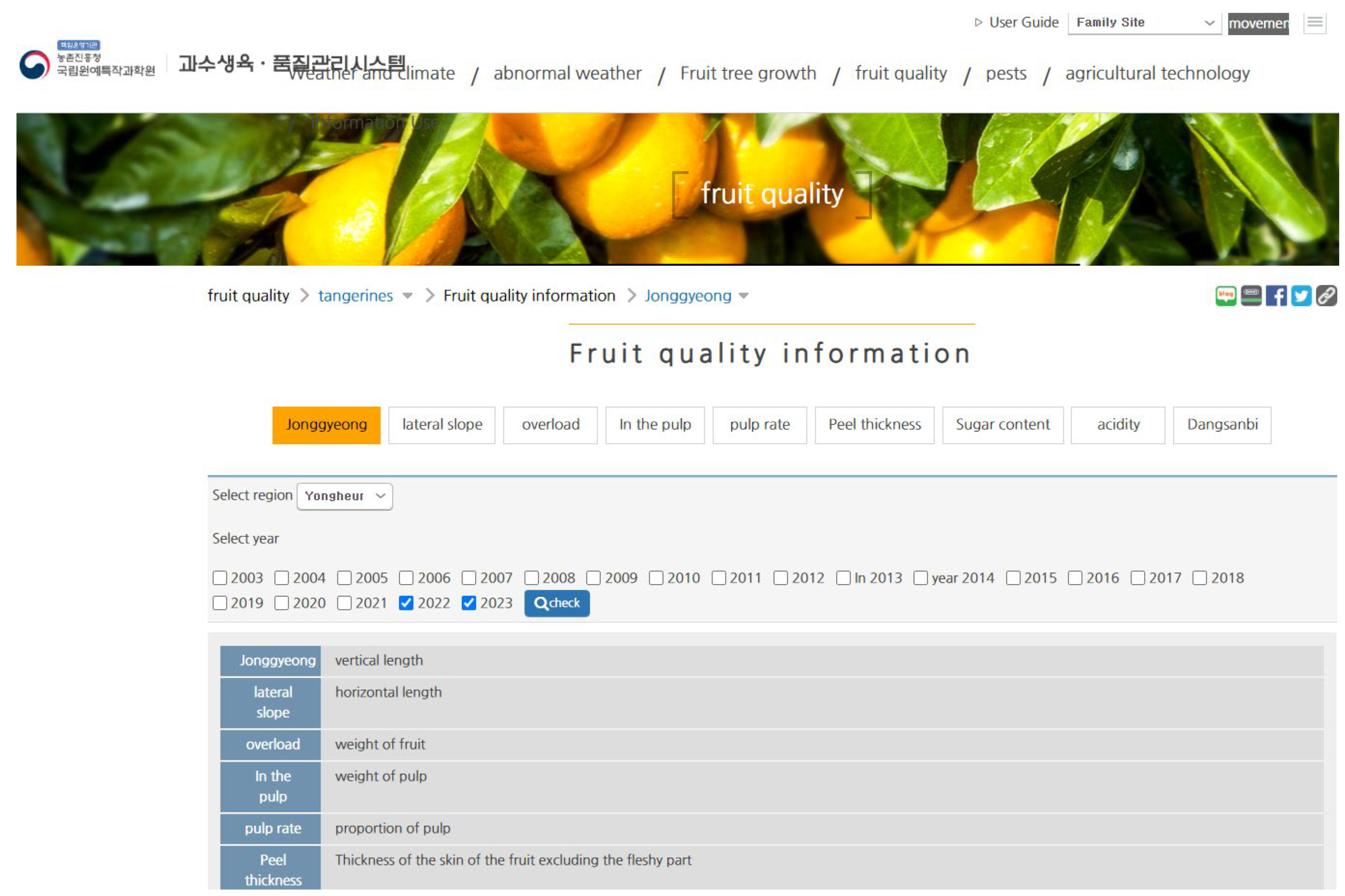

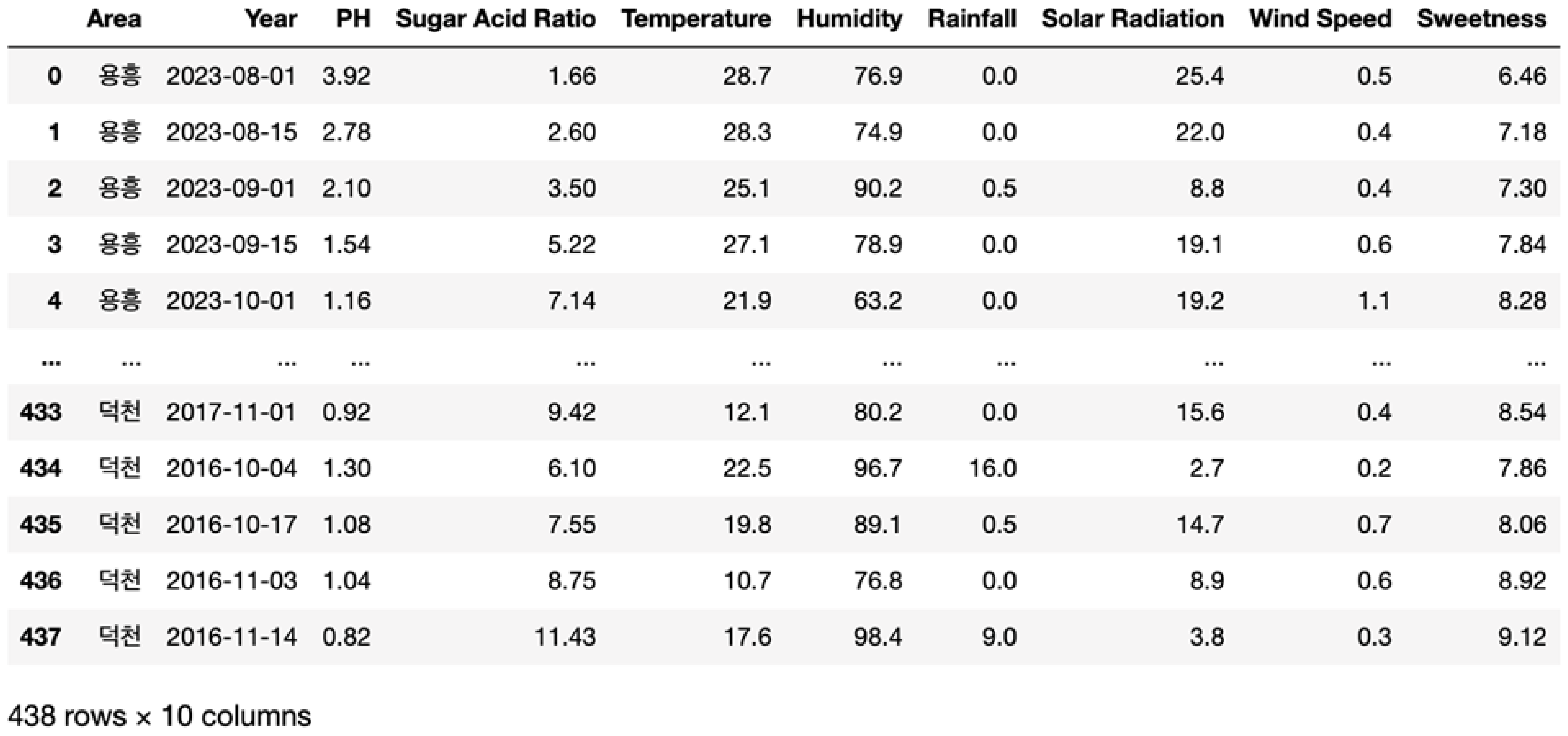
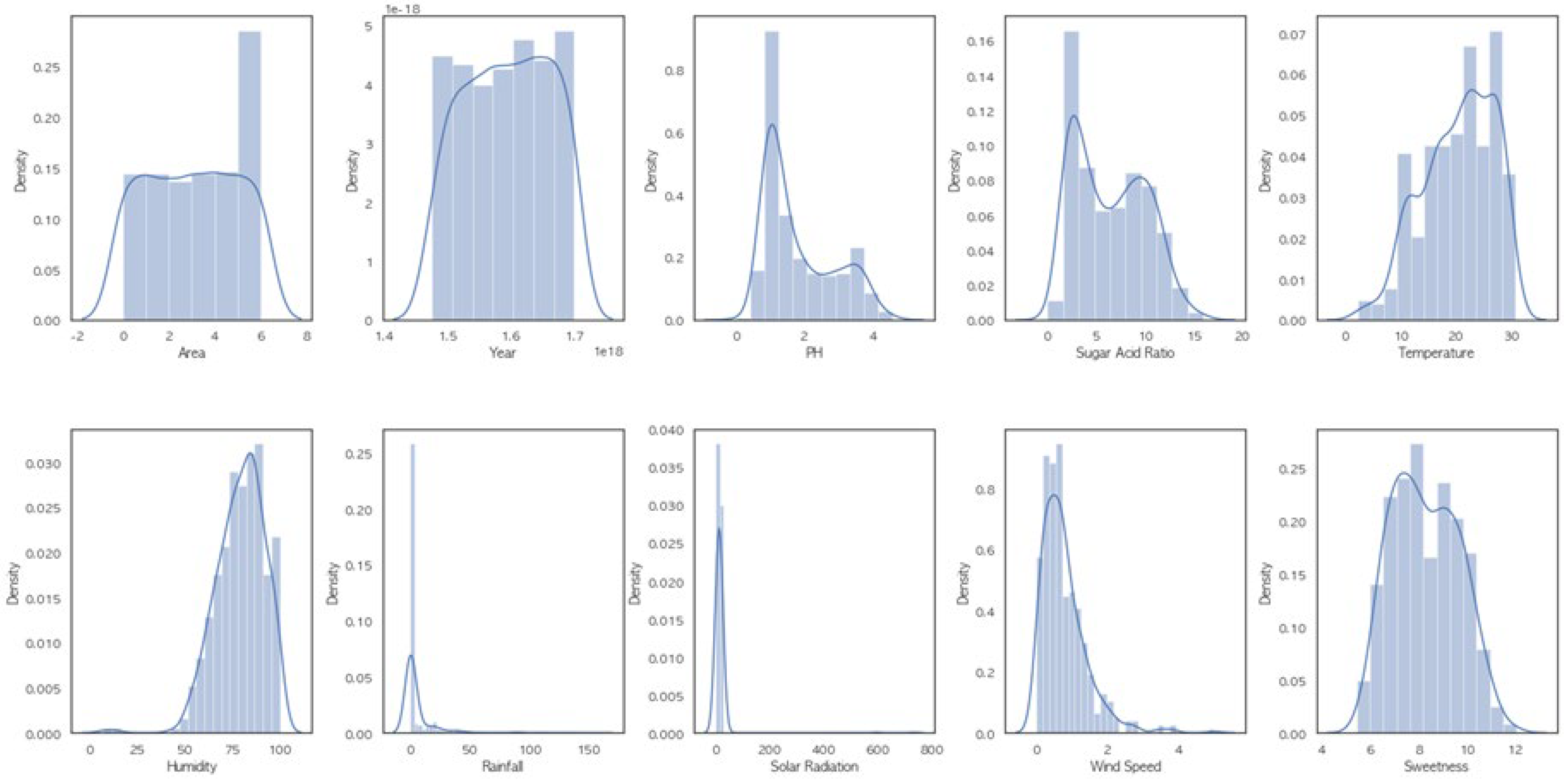
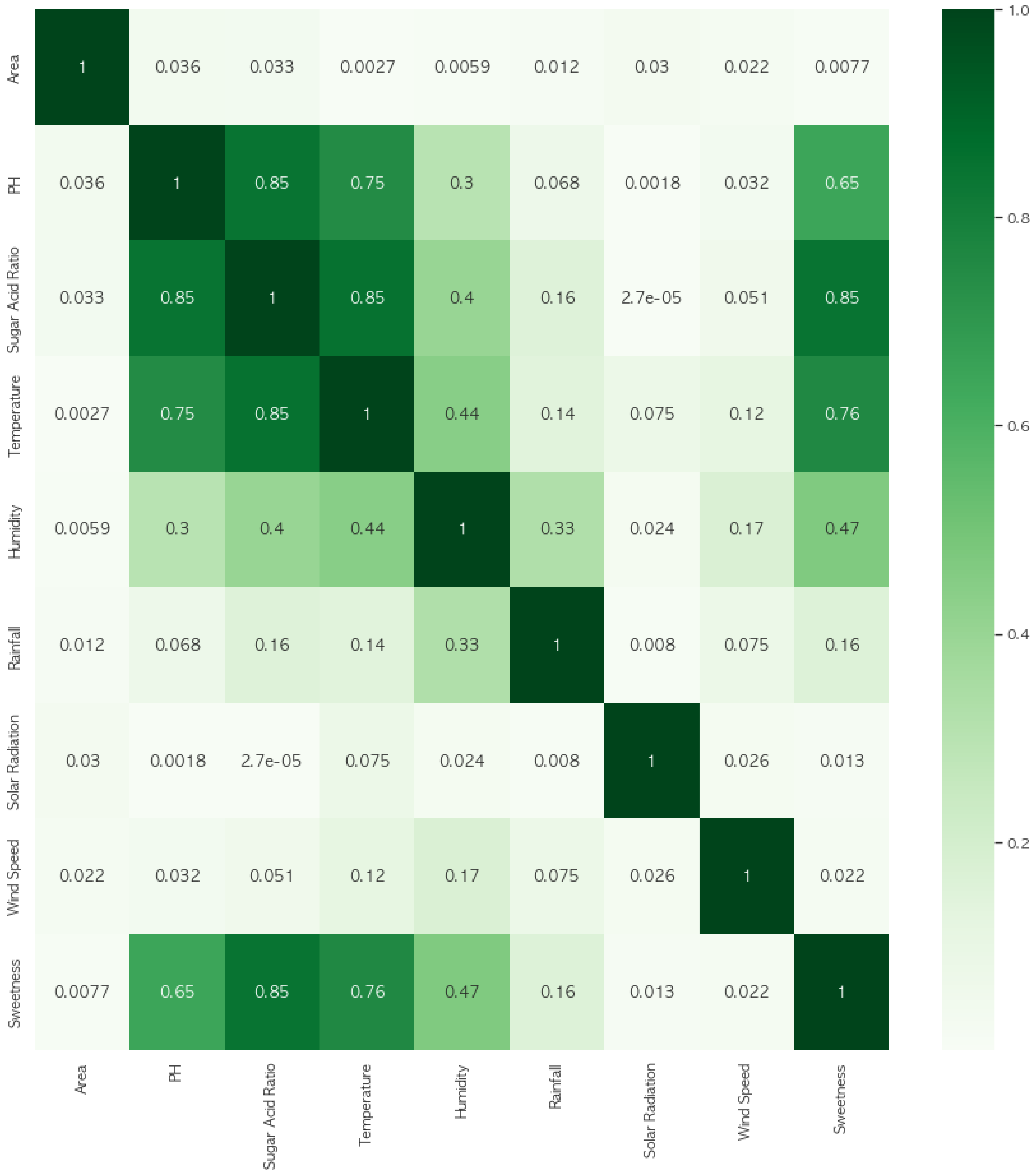

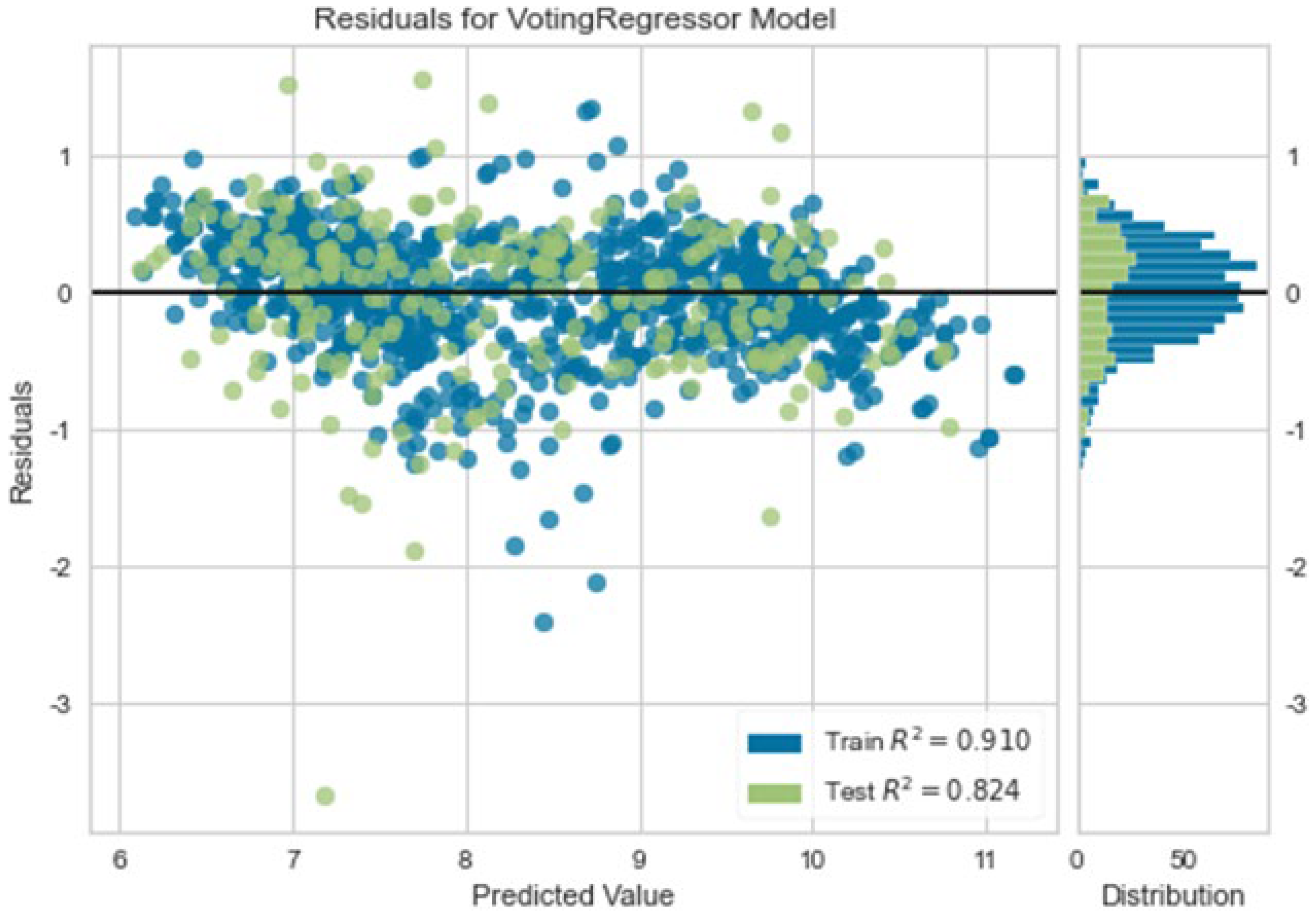
| No | Factors | Characteristics | Applicability |
|---|---|---|---|
| 1 | Longitudinal Diameter | This is an indicator for measuring the length of a fruit and indicates the vertical length of the fruit. | X |
| 2 | Transverse Diameter | This is an indicator of the width of the fruit and refers to the horizontal length of the widest part. | X |
| 3 | Fruit Weight | This refers to the total weight of one fruit and is a basic indicator to evaluate the size and growth of the fruit. | X |
| 4 | Pulp Weight | This refers to the weight of the flesh, which is the edible part of the fruit and is the weight of the pure flesh excluding the non-edible parts from the total weight of the fruit. | X |
| 5 | Juice Yield | This is the ratio of the amount of juice that can be extracted from a fruit divided by the total weight of the fruit, indicating the efficiency of juice production. | X |
| 6 | Peel Thickness | This indicates the thickness of the fruit’s outer skin and has a significant impact on its protection and texture. | X |
| 7 | Acidity | This is the acid concentration in the fruit and is an indicator to evaluate the sourness and quality of the fruit. | O |
| 8 | Sugar to Acid Ratio | This is the ratio of the sweetness and acidity of the fruit and is an indicator to evaluate the balance of the taste of the fruit. | O |
| 9 | Temperature | This represents the temperature of the air and is an important environmental factor for the growth and development of fruit. | O |
| 10 | Humidity | This indicates the moisture content in the air and affects the moisture absorption and transpiration of plants. | O |
| 11 | Precipitation | This refers to the amount of precipitation over a certain period of time and is essential for the growth of plants as a source of water. | O |
| 12 | Solar Radiation | This is the amount of sunlight reaching a certain area and plays an important role in photosynthesis and energy production in plants. | O |
| 13 | Wind Speed | This refers to the speed of the wind and affects the transpiration and temperature control of plants. | O |
| Division | Contents |
|---|---|
| Experiment Purpose and Meaning |
|
| |
| |
| |
| |
| Region |
|
| Citrus Production Data |
|
| Data Occurrence Period |
|
| Data Augmentation |
|
| Data Collection |
|
| Machine Learning |
|
| Prediction Hit Rate |
|
| |
| |
| Application and Expected Effects |
|
| |
|
Disclaimer/Publisher’s Note: The statements, opinions and data contained in all publications are solely those of the individual author(s) and contributor(s) and not of MDPI and/or the editor(s). MDPI and/or the editor(s) disclaim responsibility for any injury to people or property resulting from any ideas, methods, instructions or products referred to in the content. |
© 2024 by the authors. Licensee MDPI, Basel, Switzerland. This article is an open access article distributed under the terms and conditions of the Creative Commons Attribution (CC BY) license (https://creativecommons.org/licenses/by/4.0/).
Share and Cite
Kim, Y.; Byun, Y.-C.; Lee, S.-J. A Study on Sugar Content Improvement and Distribution Flow Response through Citrus Sugar Content Prediction Based on the PyCaret Library. Horticulturae 2024, 10, 630. https://doi.org/10.3390/horticulturae10060630
Kim Y, Byun Y-C, Lee S-J. A Study on Sugar Content Improvement and Distribution Flow Response through Citrus Sugar Content Prediction Based on the PyCaret Library. Horticulturae. 2024; 10(6):630. https://doi.org/10.3390/horticulturae10060630
Chicago/Turabian StyleKim, Yongjun, Yung-Cheol Byun, and Sang-Joon Lee. 2024. "A Study on Sugar Content Improvement and Distribution Flow Response through Citrus Sugar Content Prediction Based on the PyCaret Library" Horticulturae 10, no. 6: 630. https://doi.org/10.3390/horticulturae10060630
APA StyleKim, Y., Byun, Y.-C., & Lee, S.-J. (2024). A Study on Sugar Content Improvement and Distribution Flow Response through Citrus Sugar Content Prediction Based on the PyCaret Library. Horticulturae, 10(6), 630. https://doi.org/10.3390/horticulturae10060630







